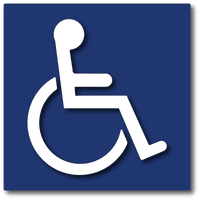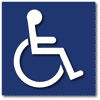
Wheelchair Symbol of Accessibility ADA Signs
The International Symbol of Access (ISA)
You've seen it just about everywhere, haven't you? At building entrances, in parking lots, beside ramps and at checkout stands. It is without a doubt the most visible sign in the world of access compliance: The Wheelchair Symbol. This ubiquitous ADA symbol consists of a blue square overlaid in white with a stylized image of a person using a wheelchair. The wheelchair symbol is "International" and therefore not accompanied by Text or Braille in any particular language.
Looking for Dynamic Wheelchair Symbol Signs required by New York and Connecticut? We are happy to make any sign shown on ADASignDepot.com, or any custom designed compliance signage you need, using the dynamic-style wheelchair symbol. Add the compliance signs you want to the shopping cart, and under Job Details for ADA Sign Depot, write any special instructions for your order. E.g., Use Dynamic Wheelchair Symbol. It's as easy as that. But if you have any questions, please contact us.
 Maranda, California
Maranda, California "I contacted ADA Sign Depot with a special request and was delighted by the can do response and fast turn around. The signs were beautifully crafted and arrived in less time than anticipated. I would absolutely recommend the signs and service as the team were knowledgeable and professional at every turn."
March 27, 2017
The California Division of the State Architect 11B-703.7.2.1 International Symbol of Accessibility. The International Symbol of Accessibility shall consist of a white figure on a blue background. The blue shall be equal to Color No. 15090 in Federal Standard 595B. EXCEPTION: The appropriate enforcement agency may approve other colors to complement décor or unique design. The symbol contrast shall be light on dark or dark on light.
The U.S. Access Board provides the following guidance on use of the International Symbol of Accessibility (ISA) under the Americans with Disabilities Act (ADA) and the Architectural Barriers Act (ABA). This guidance explains how use of a symbol other than the ISA may impact compliance with standards issued under the ADA and the ABA.
Created in 1968 through a design competition by Rehabilitation International and adopted by the International Organization for Standardization (ISO), the ISA has served as a global icon for accessibility for almost 50 years. The ISO is an independent, non-governmental organization that represents over 160 national standard-setting entities and develops voluntary, consensus-based, international standards. As part of an ISO standard (ISO 7001 Graphic Symbols – Public Information Symbols), the ISA reflects considerable analysis by, and the consensus of, an international collection of technical experts.
The ISA continues to be recognized worldwide as a symbol identifying accessible elements and spaces. Standards issued under the ADA and ABA Standards reference and reproduce the ISA to ensure consistency in the designation of accessible elements and spaces. Uniform iconography promotes legibility, especially for people with low vision or cognitive disabilities. In addition, various codes and standards in the U.S. also require use of the ISA. They include the International Codes Council’s International Building Code and ICC A117.1 Standard for Accessible and Usable Buildings and Facilities, the National Fire Protection Association’s NFPA 5000 Building Construction and Safety Code and NFPA 170 Standard for Fire Safety and Emergency Symbols, and the Federal Highway Administration’s Manual on Uniform Traffic Control Devices for Streets and Highways, among others.
Use of the ISA Under the ADA
The ADA Standards apply nationwide to places of public accommodation, commercial facilities, and state and local government facilities. Promulgated by the Department of Justice (28 CFR Parts 35 and 36) and the Department of Transportation (49 CFR Part 37), the ADA Standards require use of the ISA to label or provide direction to certain accessible spaces and elements, including parking spaces, entrances, toilet and bathing facilities, and check-out aisles (§216 and §703.7.2.1). In addition, ADA Standards for Transportation Vehicles (49 CFR Part 38) implemented by the Department of Transportation (DOT) require that the ISA be used to designate accessible vehicles.
A symbol other than the ISA will not comply with the ADA Standards unless it satisfies the “equivalent facilitation” provision (§103). This provision allows alternatives to prescribed requirements if they result in “substantially equivalent or greater accessibility and usability.” The burden of proof in demonstrating equivalent facilitation rests with the covered entity in the event of a legal challenge. Under DOT’s ADA Standards, certain entities responsible for transportation facilities and systems, as well as manufacturers of products and vehicles used in transportation systems, can request a determination of equivalent facilitation from DOT as outlined in its ADA regulations (§37.7 and §37.9). If a court — or DOT, where DOT’s ADA Standards are being applied — determined that an alternate symbol did not provide “equivalent facilitation,” that symbol would not be permitted.
Use of the ISA Under the ABA
Standards issued under the ABA apply to facilities designed, built, or altered with federal funds or leased by federal agencies. The ABA Standards are implemented by the Department of Defense, the Department of Housing and Urban Development, the General Services Administration, and the U.S. Postal Service. Like the ADA Standards, these standards mandate use of the ISA to label or provide direction to certain accessible spaces and elements (§F216 and §703.7.2.1).
Any departure from the ABA Standards, including the referenced ISA, requires a waiver or modification (§F103). The agencies that implement the ABA Standards have authority to grant modifications and waivers on a case-by-case basis where “clearly necessary.” Modifications and waivers are rare and are usually considered only in unique circumstances that make compliance with certain provisions exceptionally problematic. The Access Board is responsible for making sure that modifications and waivers are based on findings of fact and are consistent with the ABA.
Summary
Use of a symbol other than the ISA is permitted under the ADA Standards only if it satisfies the equivalent facilitation provision and under the ABA Standards only if a waiver or modification is issued. Otherwise, where the ADA or ABA Standards require accessible spaces or elements to be identified by the ISA, the ISA must be used even where a state or local code or regulation specifies a different symbol. Those who are interested in implementing an alternative symbol of accessibility are encouraged to contact the ISO’s Technical Committee 145 on Graphic Symbols which maintains the graphic symbol standards.









































